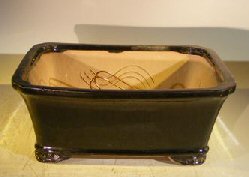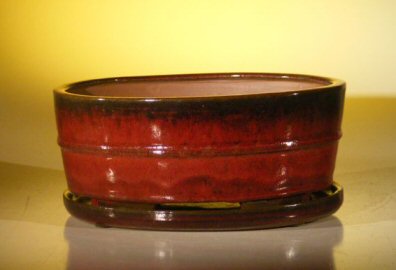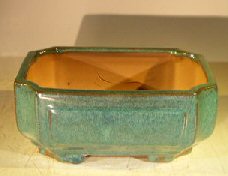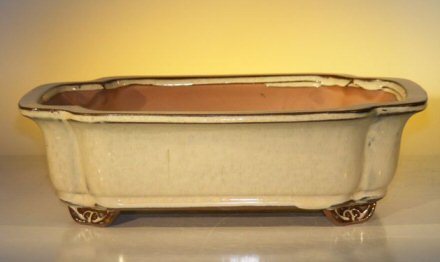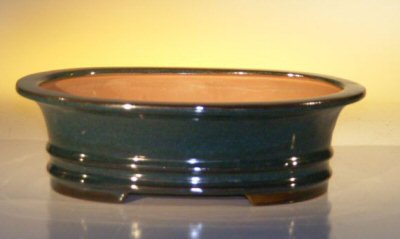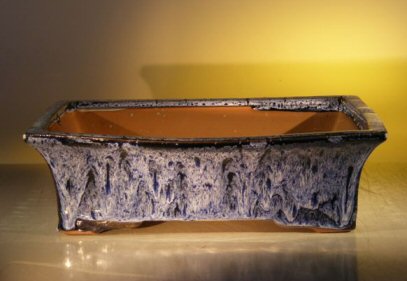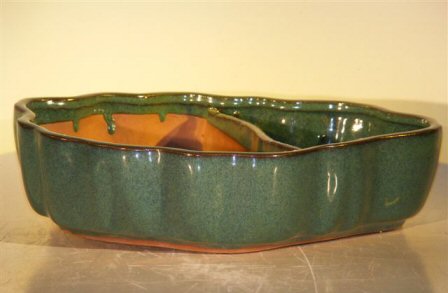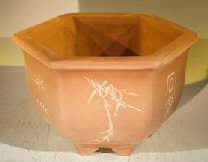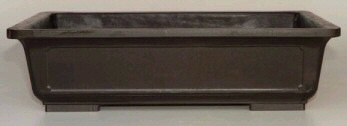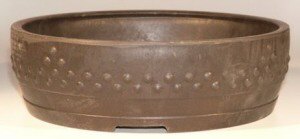When you see a bonsai tree planting, what do you think of? For many people, bonsai is synonymous with calm, relaxed feelings mixed with the wonder of a tiny tree seemingly growing out of nothing.
Achieving that vision requires more than just a healthy bonsai tree and meticulous care skills. A well-chosen bonsai pot adds that perfect finishing touch and can help your bonsai flourish for the long term.
Today, you’ll learn the details of 11 of the best bonsai pots on the market, as well as helpful shopping tips and answers to common questions.
All the products we’ll cover here are available from Bonsai Boy of New York. We believe that Bonsai Boy offers one of the best selections to buy bonsai pots, trees, supplies and accessories you could ask for. And we love the reasonable prices!
RELATED: If you’re still on the fence about which bonsai tree to plant in your new pot, check out our post where we review beginner-friendly bonsai trees.
Let’s get started!
Table of Contents
Our Picks for the Best Bonsai Pots
We’ll be looking at a few of Bonsai Boy’s Professional Series pots in this review, and this one is up first!
All Professional Series options have a few features in common:
- Extra depth vs pots of similar length measurements
- Includes bonsai anchoring wires
- Pre-made grooves for attaching root anchor wires
- Includes ultra-strong drainage hole covers
The exact pot measurements are 10 inches long, 8 inches wide and 4 inches deep. Especially if you’re looking for a new home for an established, larger bonsai, the extra pot depth and pre-secured wires can be a help.
Colored bonsai pots can be a fun choice, but you can never go wrong with basic black! With its combination of a neutral color and a glossy finish, this pot is equally at home alongside minimalist decor or a traditional theme.
Subtle design details enhance the classy feel but don’t interfere with the striking color. The top and lower edges have barely-there ridges, and the four feet also have a classic, clawfoot design. One of my favorite designs for a bonsai pot!
Another Professional Series option, this bonsai pot features extra depth and comes pre-wired for your convenience. Measuring 10.75 inches long, 8.5 inches wide and 4.125 inches deep, you’ve got plenty of room to work with.
As far as appearances go, this bowl has a simple oval shape that complements a variety of bonsai shapes and structures. The two-toned red and black glaze manages to look both understated and intriguing at the same time.
One nice feature this pot has to offer is the attached drip/humidity tray, which serves a couple of purposes.
For indoor bonsai, a drip tray is an essential piece to prevent water damage on furniture. But finding just the right one to fit your pot’s dimensions and aesthetic can be a challenge. Since this pot comes with its own tray, you know it’s a perfect match in color, size and shape.
The tray also holds a bit of extra water, which slowly evaporates and creates slightly higher humidity levels around your bonsai. This can be helpful for trees that prefer more moisture in the ambient air, usually trees that are native to tropical climates.
If your bonsai is any of these species, it will appreciate extra humidity:
- Ficus (all subspecies)
- Carmona, also called Fukien tea tree
- Dracena marginata
As a final benefit, the drip tray’s wide, flat base provides excellent stability.
Thanks to a combination of a unique shape and attractive color, this bonsai pot stands out from the crowd.
Building on a basic rectangular pot shape, the indented corners are a fun touch that adds a bit of class. The long side walls also feature additional width for an impressive stacked look.
In addition to the structural details, the sea foam green glaze has a dreamy quality that vaguely resembles something you might see on an antique. The soft color can also create a striking contrast with your bonsai’s vibrant green foliage and dark brown trunk.
This Professional Series pot offers inner dimensions of 8.25 inches in length, 6.5 inches in width and 4.0 inches in height. Also included: root-securing wires and covers for drainage holes.
This off-white bonsai pot may have a simple appearance, but don’t be deceived! There are multiple great features just below the surface.
Especially when you have a striking bonsai that you want to show off, this pot’s soft coloring won’t compete for attention. And the neutral shade is also the perfect addition to almost any home decor.
For a little visual interest, the top lip and clawfeet have a distressed finish that adds an antique feel. The walls have small outcroppings that give it a unique pot shape and add a bit of extra space.
The size measurements are generous, at 12 inches long, 9.5 inches wide and 3.375 inches tall. Also, this pot is sturdy and feels heavier than it looks, so your tiny tree can grow in safety.
With its lovely deep green coloring, your bonsai might look as if it’s springing up from a mossy enchanted forest floor.
To complete the look, you could add a layer of actual moss to the soil’s surface or a frog figurine. Whatever you choose, the simple oval shape doesn’t have any corners or angles to detract from your woodland landscape (or any other look you prefer!)
Two small ridges along the lower edge provide a nice balance with the wide upper lip. Extra-wide feet provide top-notch stability, and they blend seamlessly with the pot’s overall structure.
The interior measurements for this pot are 8.5 inches long, 5.5 inches wide and 2.25 inches tall. Perfect for an indoor tabletop or an outdoor display!
The blue-and-white color scheme on this pot is somewhat reminiscent of classic Chinese pottery and art during the Tang dynasty (618 A.D.-907 A.D.). At this time, the color blue was highly prized as a rare and beautiful element that signaled wealth and importance.
Even though the traditional Chinese pottery often depicted pastoral or other nature scenes, this pot features an abstract marbled pattern. The understated design makes for a striking addition to an indoor or outdoor bonsai garden.
The side walls have a gentle outward curve, forming a slight lip around the upper edge. And graduated cut-outs along the bottom edge add another visual element.
With this bonsai pot being 12 inches long, 9.5 inches wide and 3.4 inches tall, your tree will have no problems with cramped quarters.
This lovely blue-green bonsai pot is an example of the land and water style. This glazed ceramic bonsai pot feature a dividing wall that creates two separate interior compartments, one for water and one for soil.
You’ll notice from the photo that one side of the pot has a glazed interior; this is the side for water. The glaze prevents water from seeping through the walls of the pot, and there are also no drainage holes.
Not surprisingly, the other compartment is for your bonsai tree. This side has the unglazed interior and pre-drilled drainage holes your tree needs to stay healthy.
Some gardeners use land and water pots to make a charming decorative waterscape. You could even add a fisherman figurine or other decorative elements to create the calming look you’re envisioning.
However, captive water tends to take on a discolored, dirty appearance after a while. As an alternative, many bonsai gardeners choose to fill the water compartment with sand, moss, pebbles or blue beads instead of water.
With interior measurements of 7 inches long and 5.5 inches wide, this small oval pot is perfect for a small bonsai tree.
Unglazed ceramic is a fantastic choice when your primary goal is to highlight the natural beauty of a mature or showpiece bonsai tree.
This oval pot has a simple, elegant shape but boasts the subtle artistic touch of two slight sidewall outcroppings. The gentle shaping creates an abstract, almost flower-like look that suits the natural beauty of bonsai.
Soft tan coloring serves as an unobtrusive backdrop to your bonsai’s graceful trunk shaping and artfully pruned foliage. With the earthen color, it almost looks like your bonsai tree is growing in its own natural habitat.
Thanks to its naturally porous structure, unglazed ceramic is unparalleled when it comes to aeration. Without a shiny glaze acting as a seal, air and moisture can pass through the pot’s walls.
Measuring 12 inches long, 9.625 inches wide and 3.5 inches tall, this pot makes a happy home for older bonsai trees.
This bonsai pot looks refreshingly different from the others we’ve looked at so far, for a few reasons.
First of all: The height. Standard bonsai pot dimensions are much shallower than they are wide, and that design works well for most bonsai trees whose branches grow outwards horizontally. (We’re going to cover the significance of a shallow bonsai pot in more detail a little later on!)
However, this option is a cascade pot, and it measures 9 inches wide at the widest point, 8 inches wide at the narrowest point and a full 7 inches tall.
Why the size difference? Some bonsai trees have a cascading shape, meaning that the branches drape downwards toward the ground.
Here’s a visual:

This means you’ll need a taller pot to keep your bonsai tree elevated off the ground. What’s more, it takes a great deal of time, patience and skill to achieve that gorgeous cascading shape, and you need a pot that lets you show it off!
This pot boasts another attractive feature in its hexagonal shape, which adds some geometric visual interest. The six flat wall panels also provide the perfect canvas for stunning, delicate etchings of Chinese art and lettering.
Lastly, the sandstone color creates a soft background that subtly enhances the beauty of your cascading bonsai without distraction.
If you’re looking for an ultra-strong bonsai pot with simple lines and natural color, this may be your perfect fit!
All of Bonsai Boy’s mica pots are made in Korea, and this one is no exception. The wide, stable shape and strong mica offer excellent stability and protection for your tiny tree.
This rectangular pot has an earthy deep brown color to enhance your bonsai’s beauty without being a distraction. The gentle lip around the pot’s perimeter and subtle stamped design on the walls add just a bit of visual interest.
This pot has inner dimensions of 8.25 inches long, 5.75 inches wide and 2.75 inches tall, making it ideal for small bonsai that have outgrown a 6-inch pot.
Offering a generous inner diameter of 13 inches across and 3 inches deep, this bonsai pot is perfect for when you need a little extra space. Round pots can give more of a classic look to your bonsai tree as well!
This could be a great choice if you’re repotting an older, larger bonsai that has outgrown their previous home. Also, if you’re planting a bonsai forest, you’ve got plenty of room to arrange your trees to match your vision.
The rich brown color lends a calming, natural touch that looks like your bonsai is growing right in its native environment. The subtle hobnail pattern adds just enough visual interest without competing with the real star of the show- your bonsai.
Solid, thick mica provides unbeatable protection for your miniature tree. If you’re in the market for an unbreakable/chip-resistant pot, look no further than mica!
Shopping for the Best Bonsai Pot
So, what makes for a good bonsai pot? And more importantly, what makes a good bonsai pot for you?
There are three central factors to consider:
- What the pot looks like
- Its size
- The material
Let’s look at each point in more detail.
1. Shape and Color
Since it’s the first thing you notice and what you’ll see every day, choose a pot that looks attractive to you!
Do you want a pot in a show-stopping color or with intricate design details? Or maybe you’d rather have a neutral pot that lets your bonsai be the star.
Whatever your preference, there are bonsai pots out there to suit every style! So when you see a pot that catches your eye, that’s your cue to start checking into the deeper details, like the following two points.
2. Size
Choosing a correctly-sized pot is key to maintaining your bonsai’s appearance and health. If the pot is too large, you may lose control over your tiny tree’s growth rate. If it’s too small, your tree could start to wither away or even die.
So how can you choose a pot that’s just right? It’s easier than you might think!
As your first step to figuring out the proper pot size, get your measuring tape out and collect two numbers.
- The height of your tree, from the soil surface to the top of the canopy
- The diameter of the trunk at soil level
Now consider which shape of pot you want to use.
If you choose a rectangle or oval option: The pot’s length should be about 2/3 the height of your tree.
If you prefer a round pot: Choose one whose diameter is about 1/3 the height of your tree.
When it comes to determining how tall your pot should be, use your tree’s trunk measurement as your guide. Choose a pot with a depth that is roughly equal to your tree’s trunk diameter.
See? Not so hard!
3. Material
Most contemporary bonsai pots are made from either ceramic or mica.
Either of these two materials can make a happy home for your bonsai, but they each bring very different qualities to the table.
Let’s break each one down:
Ceramic. As one of the centuries-old traditional materials for bonsai pots, you’ll be joining good company when you choose ceramic.
And you can’t beat the variety of options when it comes to ceramic bonsai pots. Whether you’re looking for natural earth tones that mimic soil and sand or you want vibrant colors and unique shapes, you’ll find it in ceramic form.
However, as an earthenware product, ceramic has a delicate nature that makes it prone to chips, cracks and breaks.
Mica. Although ceramic bonsai pots are the most common option available by far, mica is gaining ground as a popular alternative.
Mica bonsai pots are formed with a careful balance of 80% mica, 15% polyethylene and 5% graphite. This blend produces a durable material that resists chips, cracks and breaking, even if you drop it on on the hard ground!
What’s more, you get this extra protection without any added weight; in fact, many mica pots weigh less than ceramic ones. Although this lightweight quality is awesome for portability, you’ll want to take some thoughtful securing precautions if your bonsai lives outdoors.
To continue that thought, mica pots are ideal for indoor or outdoor use. Mica acts as insulation for your bonsai tree’s root system, protecting it from fluctuations in the ambient temperature.
This quality is especially helpful during winter dormancy in freezing conditions. However, some bonsai gardeners find that their mica pots get too warm in areas that experience scorching summers.
One potential drawback to mica bonsai pots is the fairly limited style/shape/color options. Most mica pots are a solid brown or soft black, and they usually only come in simple geometric shapes.
Frequently Asked Questions About Bonsai Pots
Do Bonsai Trees Need Special Pots?
Yes. You definitely will not be able to grow a healthy, attractive bonsai in a standard flowerpot.
But that doesn’t mean that you have zero flexibility when it comes to choosing a bonsai pot. Many different types of vessels that allow for proper drainage and wiring will make fine bonsai homes.
However, using a pot that has a design specifically for bonsai is the easiest and most reliable route.
With a high-quality bonsai pot, you can be confident that the shape, system for drainage holes, and material all work together to benefit your tiny tree.
Why are Bonsai Pots Shallow?
This may seem like a simple question, but the answer actually has multiple facets, including:
- Your bonsai’s appearance
- Long-term tree health
- Ease of maintaining proper soil moisture
Let’s break it down:
Appearance. A shallow bonsai pot closely mimics the look of a tree growing in its natural state: Straight out of the ground. Without any extra pot depth to get in the way, your bonsai looks as though it’s springing up from the table or other display surface.
Also, some bonsai growers feel that a shallow pot highlights the tree’s trunk color and shape by putting it in easy view.
Healthy root development. Growing in shallow soil forces your bonsai to develop stronger lateral (outward-reaching) roots rather than a deep taproot (a downward-reaching root.)
A thriving lateral root system helps allows your tree to absorb more soil nutrition so it can stay healthy. Lateral roots are also easier to trim during repotting, giving you better control of your bonsai’s growth rate.
Also, you can train your bonsai to produce a stunning network of nebari, which are roots that grow above the soil.
If you aren’t familiar with this term, here’s a picture of a juniper bonsai with prominent and beautiful nebari:

A shallow pot is awesome for both showing off existing nebari and potentially helping your tree develop new ones.
Soil moisture. The soil in a shallow pot tends to hold more moisture and drain at a more even pace than soil in a deep pot. This quality can reduce your watering frequency and also make each watering session more effective.
This point becomes especially important if your bonsai prefers higher soil moisture. Japanese maples and Hawaiian umbrella tree are two examples of bonsai that prefer moist conditions, making a shallow pot the perfect choice.
On the other hand, trees like juniper and pine aren’t as picky about moist soil. You can still use a shallow pot for aesthetic purposes, but a slightly deeper pot can make a comfortable home for these species.
Why Are Bonsai Pots So Expensive?
No doubt about it: You’ll pay significantly more for a bonsai pot than you will for a standard-issue terra cotta flower pot.
Why is that? The primary reason is that almost all high-quality bonsai pots are made by hand.
This includes shaping the ceramic pottery, firing it in the kiln and adding a colored finishing glaze. It’s a little easier to mass-produce mica pots, but skilled workers still need to oversee the production process.
All those steps require time and skill, and in some regions, artisans have invested generations into perfecting their production routine. These pots offer top-notch craftsmanship, beauty and function, hence the premium price tag.
But there’s good news: Not all high-quality bonsai pots are out of reach if you’re on a limited budget.
One of the reasons we’ve chosen to highlight Bonsai Boy is their vast supply of beautiful, well-made Chinese pottery for reasonable prices. A winning combination!
Not only that, but Bonsai Boy also offers a massive collection of bonsai trees, supplies and other accessories to help you on your bonsai journey.
Final Thoughts
Selecting the right pot for your bonsai means that your tree can grow happily at the proper pace and you can create the bonsai look that is a perfect fit for your taste.
There may be a myriad of choices out there, but the best bonsai pot comes with a solid reputation for both quality and value.
That way, you can take good care of the bonsai you already have while also socking away some extra cash for your next one!
We’d love to hear about your experiences with bonsai pots! Which one on our list did you like the most, or do you have any other suggestions to share?
We want to hear from you in the comments!


